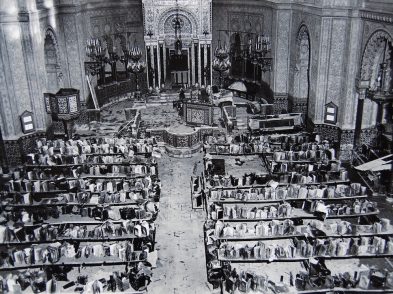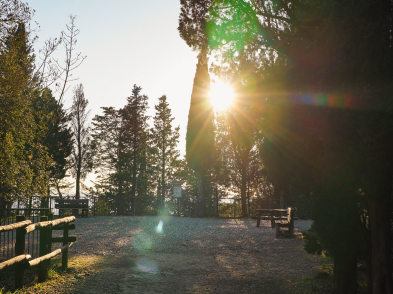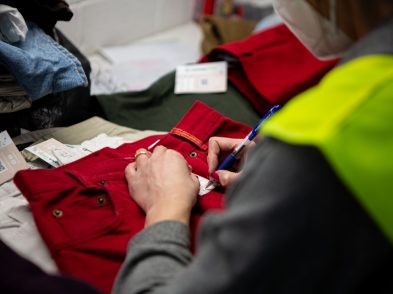In the Renaissance city, modern sacred art often goes un-noticed, yet the period from the middle of the nineteenth to the middle of the twentieth centuries was one of fertile production of a spirituality rendered visual by Italian and international artists. Some 100 of these expressions, in paint, print and sculpture, are part of the exhibit Divine Beauty from Van Gogh to Chagall and Fontana at Palazzo Strozzi from September 24 to January 24.

The revival of sacred subject matter in Italian painting began in the 1860s, when there was a move towards integrating contemporary concepts of beauty into images of ideal, spiritual perfection. In the period studied, the actions of Pope Pius IX, who ordered that standards and paintings created for beatifications and canonisations be displayed in the Vatican in 1869, and of Pope Paul VI, who inaugurated the Collection of Modern Religious Art in the Vatican Museums in 1973, are essential for the definition and study of these works that are, perhaps, still too close in time to our own experience to fully appreciate. We tend to think of modern art as expressing modern themes, like interior psychology or exterior landscapes – while religious topics suffer the stigmatism of being connected with a past from which we think we’ve broken. Yet stylistically, as this this exhibit shows, these works are both individualistic and modern, and the spiritual – more so than the dogmatically religious – has a strong presence in this age.

If there’s one thing that stands out in the Strozzi exhibit, it’s that there is little visual cohesion between the works on display. What cohesion there is comes from the grouping of topics, presented both through iconographical themes and in rough chronological order. The show starts with an opening room of mid nineteenth century works that are all quite different from one another. As we move through time, exploring themes of Marian devotion and representations of various parts of the life of Christ, some of the most interesting works are those that “have sprung from a spiritual solipsism that extended beyond the boundaries of official art in expressive and profound free associations.” (Catalogue, p. 53) A Munch lithograph entitled Madonna II includes a scary alien figure in the corner and a spermazoidal frame decoration that connects life and death, miracle and nightmare, in a persona interpretation that rejects traditional religious iconography.

In the 20th century, especially around WWII, many artists addressed themes of Crucifixion, Deposition, Pietà and Resurrection, and the most interesting ones continue to break with tradition. The Contemporary Crucifixion – Cycle of Protest no. 4 by Emilio Vedova (1953, on loan from Rome’s GNAM) caused disconcertion at the time because of its extremely abstract rendering of the Crucifixion in which the form of the iconography is barely visible, hidden in the energy of the almost monochromatic brushstrokes, that nonetheless include a cross-like form in the centre and a red pool of paint below it.

A painting that Pope Francis recently said is his favourite work of art is Marc Chagall’s White Crucifixion (1938), painted during the Nazi persecution of the Jews as an act of denunciation. Christ on the Cross becomes a lyrical testimony of the condition of the Jews, with Christ presented as a martyr, wearing not a loincloth but a Jewish prayer cloth (tallit), and surrounded not by fluttering angels but by biblical patriarchs and matriarchs clad in Jewish garments.

The exhibition closes with a deeply personal work in the section dedicated to prayer. Felice Casorati’s The Prayer (1914) shows a young woman in a field of flowers, head bent, the crest of the horizon like a world that embraces her. Inspired by Klimt and other Secessionists, the painting’s decorative patterning has nonetheless a kinship with the reflective, simple beauty of Fra Angelico at San Marco, expressing a feeling of serenity achieved through individual prayer.
The exhibition is co-organized by Palazzo Strozzi with the Archdiocese of Florence and the Vatican Museums. It’s part of a programme of events for this November’s Fifth National Bishops Conference, which Pope Francis will attend. It also coincides with the upcoming reopening of the Museo dell’Opera del Duomo, providing an opportunity of comparison amongst multiple periods of religious art.
As always, Palazzo Strozzi encourages us to explore connected works in Florence and in Tuscany with a free guidebook to modern religious art. In Florence, interestingly, nineteenth-century Anglo-Saxon commissions stand out: the Chapel of the Villa Favard by Giuseppe Poggi for Suzanne Bacheville, future Baroness; St. James’ American Episcopal Church in a neo-Medieval style inspired by English architecture of the period; and St. Mark’s Anglican Church on via Maggio, home to English Pre-Raphaelite decorations.
VISITOR INFODivine Beauty from Van Gogh, Chagall and FontanaPalazzo Strozzi24 September 2015 – 24 January 2016www.palazzostrozzi.org







